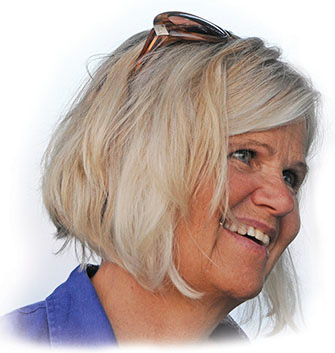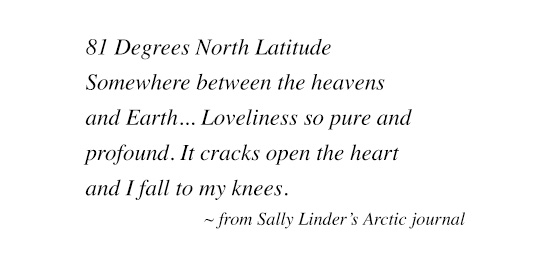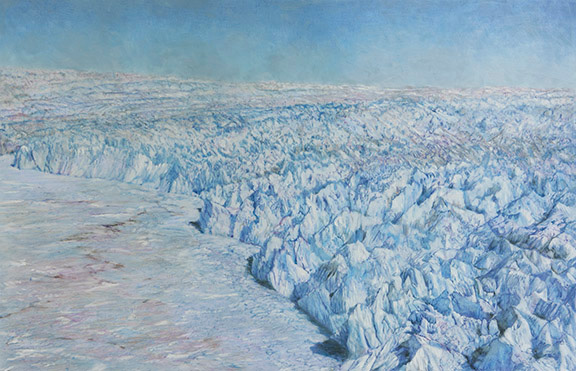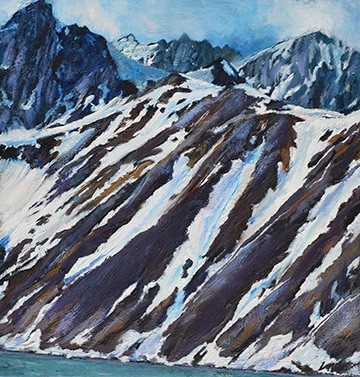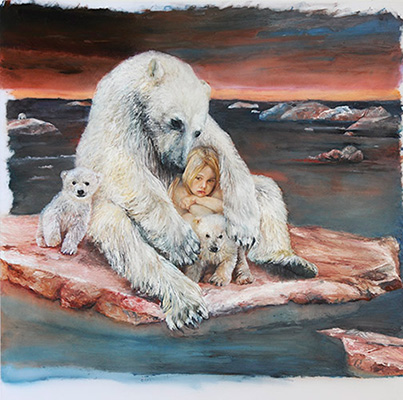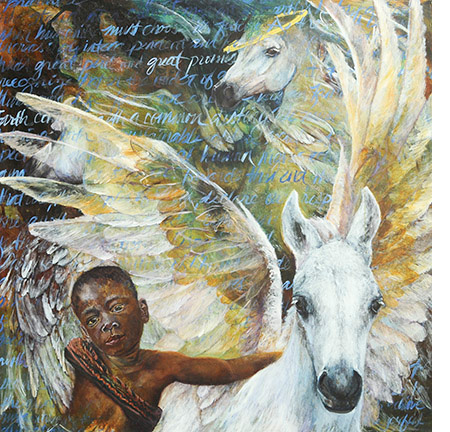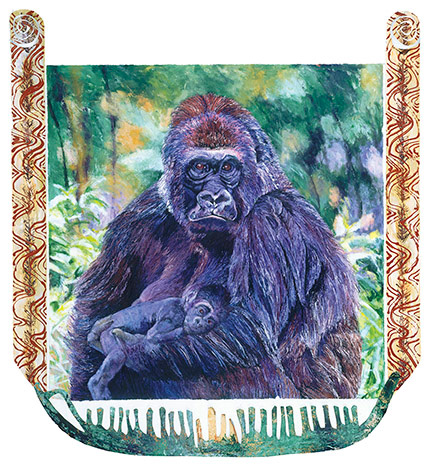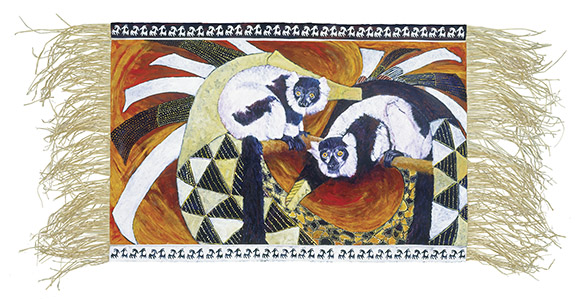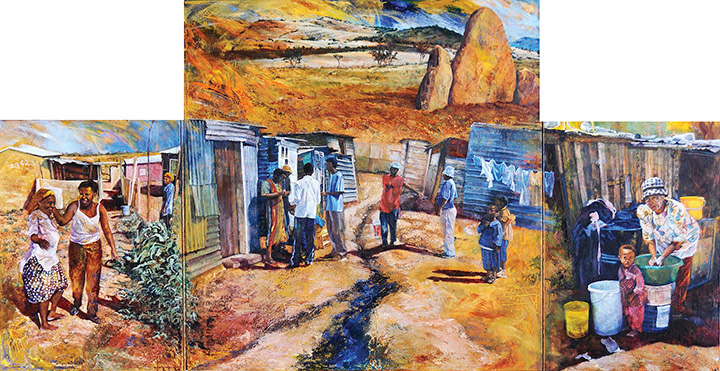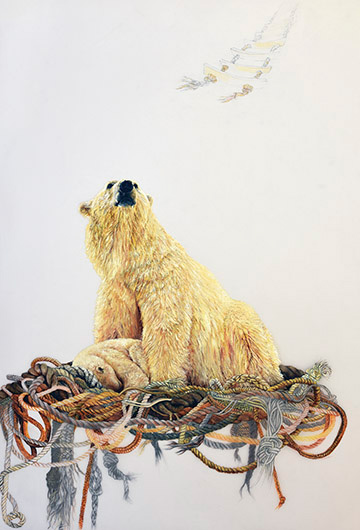Sally Linder: Artist, Humanist, Activist |
||||||||||
| by Cynthia Close | ||||||||||
|
||||||||||
Sally Linder’s environmental activism is her art. It is not some altruistic activity to be engaged in at a convenient time and place: her art is the core of her being. It is life itself. Born in Brookline, Massachusetts, in 1951, this well-known Burlington-based artist has had a long and illustrious career. At the age of 12, before she fell in love with art, she fell in love with Robert Linder, whom she married in 1971. They moved to Canada where Linder studied painting and creative writing at McGill University, ultimately earning a BA from Goucher College, followed in 1975 by a BFA from Concordia University, where she received the Board of Governor’s Medal for Creative Work in Visual Arts. Accolades have followed Linder throughout her creative life, but they were not pursued. They were the results of her many journeys. Artists by nature are seekers of truth. For Linder this search involved deep, internal investigation, at times in isolation, surrounded by harshly beautiful, unforgiving environments. The first of these took place in 1975–1976 when Linder lived alone, in the winter, without telephone, electricity, or running water, atop a mountain in Harrington, Quebec. To say that this experience imbued in her a profound respect for the power of nature is probably an understatement.
It was in this studio that I first encountered Linder’s most recent work, a series generated by her two voyages aboard National Geographic icebreakers, accompanied by scientists, Inuit trackers, and photographers, that explored Iceland, Greenland, and Canada above the Arctic Circle. At one point they were 500 miles from the North Pole. |
||||||||||
|
||||||||||
It was on their second trip, an attempt to sail through the Northwest Passage, when the ship, The Explorer got stuck in pack ice over six feet thick. What could have been a devastating experience turned into one of the most magical moments for Linder. The vessel remained trapped in the grip of the ice and as the blue-white mass crept up around the hull, the polar bears approached to do some exploring of their own. Linder told me the lumbering, curious bears got close enough that she could see their breath.
“The immensity of the Arctic Sweep humbles me as it enacts a story. Humanity is momentarily afforded a life-changing choice. The Arctic gifted me a vision of a land/seascape nearly undamaged, untrodden, untruncated by human dominance. This is the treasure I took back to the studio to paint.” The quote is from the artist’s statement in a catalog for Within the Circle an exhibition of Linder’s Arctic works held at Champlain College in early 2016.
Perhaps it was the realization of the dangers of this path—this belief in our separateness from and dominion over nature—that led Linder to trek alone through the canyons of Utah to live in a cave where she sought a new awareness of Earth through meditation. It was in this same year, 1995, that she consulted with Grandmother Waynonaha Two Worlds of the Lakota and Cherokee Nations on what ultimately became the Connectedness series of 11 mixed media paintings. Even her forays in city life brought Linder into close contact with spiritual reminders of the connection between the human and animal worlds. A great horned owl apparently died of old age and fell from a tree into a snowbank on the sidewalk near her Burlington studio. She found it and carried the newly dead body home where she watched, like a guardian, as it slowly decomposed over a year and a half. She then painstakingly reconstructed its skeleton and made a series of drawings titled Patience, which she likened to an old man, calling him “Grandfather.”
In my first discussion with Linder, she told me “pain was her muse.” That was certainly the case when she learned of the tragic 1995 Christmas Eve fire in the Philadelphia Zoo in which all of the zoo’s 23 primates lost their lives. She was moved to visit the zoo and collected data and photographs of each of the endangered animals from the zoo’s lead primate keeper. These included six gorillas, three orangutans, four white-handed gibbons, six ring-tailed lemurs, two ruffled lemurs, and two mongoose lemurs. In the creation of these mixed media works, she fell in love with the reimagined beings of these zoo captive primates. Each piece was more of a ritual object of remembrance then simple artwork. In 1998 Linder traveled with these primate portraits to the jungles of Borneo, Madagascar, and Cameroon, where, with the assistance of the indigenous Dayak, Antandroy, and Bakweri people, she buried the paintings of the 23 primates, allowing their spirits to symbolically return home.
Sally Linder’s restless spirit seeks expression in words as well as in visual art. She wrote Re-Membering the Primates, a book about the experience of painting the primates and returning them to their natural home. Her engagement with indigenous people during this time heightened her awareness of the power of myth. For them, mythical animals possessing magical abilities had once lived on Earth but were hunted to extinction by humans. These tribal peoples also held physically and mentally challenged children and adults in high regard, believing they had special talents. These two ideas, combining the power of myth with the disabled, led to A Part of This World, a series of paintings that seem quite unlike anything Linder painted previously, harkening back to the visionary work of the 18th-century artist and poet William Blake. The Ark of Hope is one of Linder’s most well-known and internationally celebrated projects. It is a wooden chest, designed and painted by Linder and crafted by cabinetmaker Kevin Jenness from a single plank of wood. It was created as a place of refuge for the Earth Charter, an international people’s treaty for building a just, sustainable, and peaceful world in the 21st century. It also holds over 600, handcrafted Temenos Books, made by children and adults from around the world in response to learning about the Earth Charter. Linder conceived of the book project, as part of the ark, along with fellow artist Cameron Davis. The Ark of Hope was dedicated at a celebration of the Earth Charter held at Shelburne Farms on September 9, 2001. The event featured keynote speaker Jane Goodall, along with musician Paul Winter, global peace walker Satish Kumar, and Dr. Steven C. Rockefeller, who was a founding member of the Earth Charter Commission. Two days later, on September 11, 2001, following news of the horrific terrorist attacks in New York, Pennsylvania, and Washington, DC, Linder’s immediate, spontaneous response was to begin walking the Ark of Hope to New York City. For two months, hundreds of people joined Linder on the 350-mile pilgrimage, carrying the ark through four states. In 2002 it was exhibited at the United Nations as the artistic expression of The Earth Charter. From there, Linder traveled with the ark to Johannesburg, South Africa, where she experienced the strength and dignity of black South Africans living after apartheid under harsh conditions in Diepsloot, Zandspruit, and Soweto. As with all her life experiences, her time in Africa spawned a creative burst, leading to Luminous People and Land, a series of triptychs flooded with the color and celebration of life that she found there.
The years following her segue out of Africa seemed to be a time of reconnecting with elemental aesthetic concerns. Her work has moved from being figurative and specific to abstraction. It appears to be a moment of stocktaking for Linder, which is perfectly expressed in the last stanza of her poem to explain the Metamorphosis Series:
Perhaps it is the tension between opposites—the warmth of the South African sun giving way to the chill, stillness of the Arctic, utter despair over climate change and the undeniable beauty that still exists in the natural world—that continues to drive a prolific artist like Linder. When we sat in her Burlington studio, looking at her breathtakingly beautiful paintings of the Arctic, she told me “the most toxic human milk in the world comes from women living there.” The pollution that we are producing in the industrialized world is being carried north by air and water currents that circulate around our planet. We are all indeed connected.
|
||||||||||
|
Cynthia Close is a contributing editor for Documentary Magazine, art editor for the literary journal Mud Season Review, and an adviser to the Vermont International Film Festival. She lives in Burlington, Vermont, with her doggie, Ethel.
|
|||||||||
